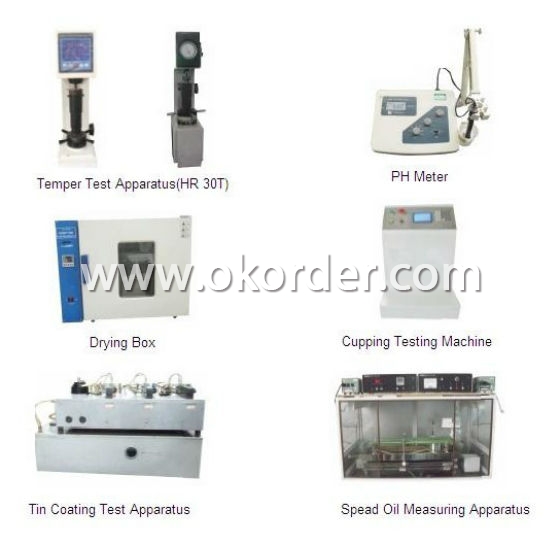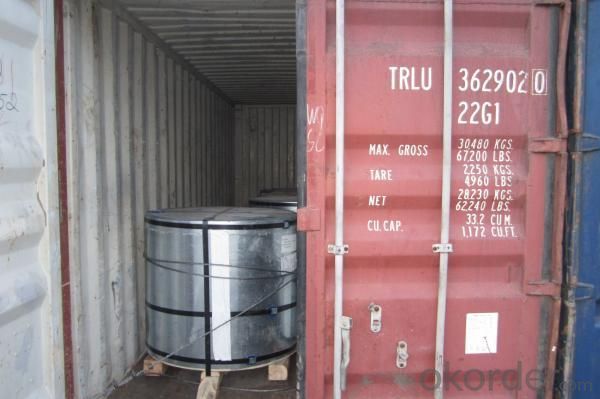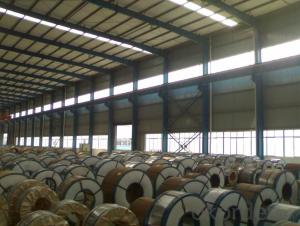Tinplate For Electrical Machinery Parts-CHBB
- Loading Port:
- China Main Port
- Payment Terms:
- TT or L/C
- Min Order Qty:
- 20 Tons ~25 Tons m.t.
- Supply Capability:
- 40000 MT Per Month m.t./month
OKorder Service Pledge
OKorder Financial Service
You Might Also Like
General information of Tinplate for Electrical Machinery Parts
|
Steel Type |
SPCC |
|
Temper (BA&CA) |
T1~T5, DR8 |
|
Coating |
2.8~8.4g/m2 |
|
Thickness & Tolerance |
0.15~0.5mm (Tolerance:±0.01mm) |
|
Width & Tolerance |
600~1000 mm(Tolerance: +2/-0mm) |
|
I.D |
508 MM |
|
Coil Weight |
3~10 MT |
|
Passivation |
311 |
|
Oiling |
DOS |
|
Surface Finish |
Bright ,Stone ,Silver ,Matte |
|
Min Order |
25 Tons for 1 20 feet FCL |
|
Package |
Seaworthy Export Standard Wooden Pallet |
|
Standard Available |
GB/T2520-2000, JIS G3303, ASTM A623, BS EN10202 |
|
Lead Time |
35 days after receiving buyer's original L/C or Prepayment |
|
Special specifications are available on customers' requirements. | |
Technical data of Tinplate for Electrical Machinery Parts
|
Chemical Composition(%) |
Mechanical Property |
|
C:0.04~0.06 |
Yield Strength: (Mpa):280~320 |
|
Si:0.01~0.03 |
TensileStrength: (Mpa):340~390 |
|
Mn:0.18~0.22 |
Elongation:20%~30% |
|
P:0.014~0.016 |
------------- |
|
S:0.006~0.009 |
Application of Tinplate for Electrical Machinery Parts


Tinplate is widely used for making all types of containers such as artistic cans, tea cans, painting cans,
chemical package cans and metal printing etc. Its applications are not limited to containers; recently,
tinplate has also been used for making electrical machinery parts and many other products.
Equipment and Facility of Tinplate
Tin Coating Line

Cold Rolling Mill Batch Annealing Furnaces


Cutting Line Stock Area


Quantity Control System of Tinplate

- Q: What are the main applications of tinplate?
- Tinplate is mainly used in the packaging industry for making cans, containers, and other metal packaging products. It provides excellent protection against corrosion, making it suitable for storing and preserving food, beverages, chemicals, and other perishable goods. Additionally, tinplate is also used in the manufacturing of aerosol cans, decorative items, and various other household products.
- Q: How does tinplate packaging contribute to product differentiation?
- Tinplate packaging contributes to product differentiation by providing a unique and attractive look that distinguishes a product from its competitors. The use of tinplate allows for creative and eye-catching designs, which can effectively communicate the brand's identity and create a memorable impression on consumers. Additionally, tinplate packaging offers durability and protection, ensuring that the product remains in good condition throughout its shelf life. This enhances the overall perceived value of the product and sets it apart from alternatives, thus contributing to product differentiation.
- Q: How is tinplate tested for corrosion resistance?
- Tinplate is tested for corrosion resistance through various methods, including salt spray testing, electrochemical impedance spectroscopy, and weight loss analysis. These tests evaluate the ability of tinplate to withstand exposure to corrosive environments and provide insights into its protective properties.
- Q: Why do tin tins rust easily when they are opened?
- The tinplate is of poor quality and the tin is not enough
- Q: How does tinplate packaging contribute to product protection against contamination?
- Tinplate packaging contributes to product protection against contamination by providing a durable and secure barrier between the product and external elements. The tin coating on the steel substrate prevents corrosion and rusting, ensuring the integrity of the packaging. This protects the product from moisture, oxygen, and other contaminants that could compromise its quality or safety. Additionally, tinplate packaging is airtight, preventing the entry of bacteria or microorganisms, further enhancing product protection against contamination.
- Q: What are the main factors affecting tinplate market growth?
- The main factors affecting tinplate market growth include the demand for packaged food and beverages, expanding industrial applications, economic growth and urbanization, government regulations and policies, technological advancements, and changes in consumer preferences and behavior.
- Q: How does tinplate perform in high humidity environments?
- Tinplate performs well in high humidity environments due to its corrosion resistance properties. The tin coating on the steel substrate acts as a barrier, preventing moisture from reaching the metal surface and causing corrosion. Therefore, tinplate is an excellent choice for packaging and other applications in high humidity conditions.
- Q: How does tinplate contribute to the efficiency of energy systems?
- Tinplate contributes to the efficiency of energy systems by providing a highly durable and corrosion-resistant material for the production of energy-efficient appliances, such as refrigerators and air conditioners. Its excellent thermal conductivity properties also aid in the efficient transfer of heat, reducing energy waste. Additionally, tinplate is widely used in the packaging of food and beverages, helping to preserve products and extend their shelf life, thus reducing food waste and energy consumption associated with production and transportation.
- Q: What are the main applications of tinplate in the energy industry?
- Tinplate is widely used in the energy industry for various applications such as manufacturing of batteries, fuel cells, and solar panels. It provides corrosion resistance and ensures the durability of these energy storage and conversion devices. Additionally, tinplate is used in the construction of transformer cores, which are crucial components in electrical power systems.
- Q: What is the tin plated iron?
- When the coating is damaged, the raw water is made up of the surrounding water, oxygen, etc.. Zinc is the anode oxidized iron tin anode is protected, do not participate in the reaction. Because zinc is more active than iron, the living metal is the negative.
1. Manufacturer Overview
| Location | Hebei,China |
| Year Established | 2009 |
| Annual Output Value | US$2.5 Million - US$5 Million |
| Main Markets | North America South America Eastern Europe Southeast Asia Africa Mid East Eastern Asia Western Europe Central America Northern Europe Southern Europe Domestic Market |
| Company Certifications | ISO9001:2000 |
2. Manufacturer Certificates
| a) Certification Name | |
| Range | |
| Reference | |
| Validity Period |
3. Manufacturer Capability
| a) Trade Capacity | |
| Nearest Port | TIANJIN |
| Export Percentage | 11% - 20% |
| No.of Employees in Trade Department | 6-10 People |
| Language Spoken: | English, Chinese |
| b) Factory Information | |
| Factory Size: | Above 100,000 square meters |
| No. of Production Lines | Above 10 |
| Contract Manufacturing | |
| Product Price Range | Average |
Send your message to us
Tinplate For Electrical Machinery Parts-CHBB
- Loading Port:
- China Main Port
- Payment Terms:
- TT or L/C
- Min Order Qty:
- 20 Tons ~25 Tons m.t.
- Supply Capability:
- 40000 MT Per Month m.t./month
OKorder Service Pledge
OKorder Financial Service
Similar products
Hot products
Hot Searches
Related keywords






























